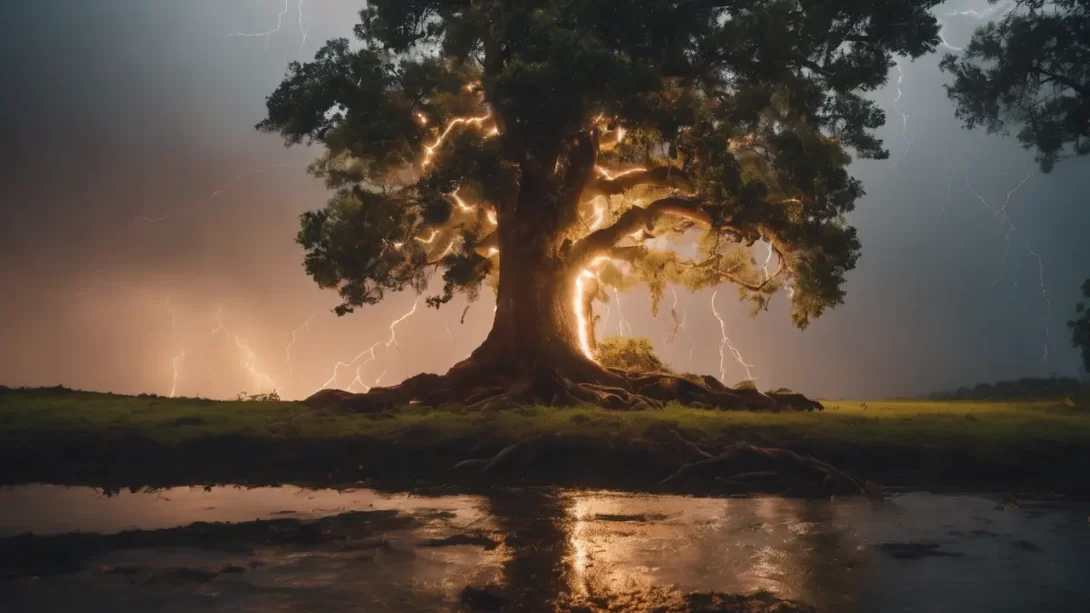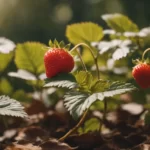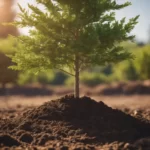Lightning striking a tree is a powerful natural phenomenon that can have significant consequences for the tree’s health and safety for its surroundings. Understanding how to identify a tree that has been hit by lightning is crucial for addressing potential hazards and assessing the tree’s future. This article will discuss the various signs that indicate a tree has been struck by lightning.
Lightning and Trees
Lightning strikes occur when there is a discharge of electricity between the atmosphere and the ground. Trees often become targets due to their height, especially in open areas. The moisture and sap inside trees conduct electricity, making them susceptible to lightning strikes. Some species of trees, like oaks and poplars, are more prone to lightning damage due to their height and high moisture content.
External Signs of a Lightning Strike
When lightning strikes a tree, it leaves several distinct external signs. These can vary based on the intensity of the strike and the type of tree but generally include noticeable damage to the bark and visible scorch marks.
Bark Damage
- One of the most common signs of a lightning-struck tree is damage to the bark. The intense heat and electrical charge can cause the bark to explode or peel off in large sections, exposing the inner wood.
- The pattern of bark damage can vary. In some cases, a long vertical strip of bark is blown off, running down the length of the tree. In other instances, the bark may be cracked or splintered in a more sporadic pattern.
Scorch Marks
- Scorch marks or charred areas on the tree’s surface are another indicator of a lightning strike. These marks are typically blackened or darkened areas where the intense heat has burned the tree’s surface.
- The size and shape of scorch marks can vary, with some lightning strikes leaving wide, blackened trails, while others may cause smaller, more localized charring.
Internal Damage to the Tree
While external signs are the most visible indicators of a lightning strike, the internal damage to a tree can be extensive and sometimes more severe.
- Vascular System Damage: Lightning can severely damage a tree’s vascular system, which is responsible for transporting water and nutrients. This damage can lead to a decline in the tree’s health, as it struggles to transport essential resources.
- Structural Integrity: The intense heat and electrical energy of a lightning strike can boil the water inside a tree’s cells, leading to internal explosions. This can compromise the structural integrity of the tree, making it more susceptible to breaking or falling.
- External Signs of Internal Damage: Although internal damage is not always immediately visible, signs such as wilting leaves, branches dying back, or sections of the tree failing to produce leaves can indicate internal injuries.
Immediate Aftermath and Long-Term Effects
The impact of a lightning strike on a tree can vary widely, depending on the intensity of the strike and the tree’s health and species.
- Immediate Aftermath: Immediately following a strike, a tree may show signs of shock, such as leaf drop or sudden wilting. The extent of visible damage can range from minor to severe.
- Long-Term Health: Over time, the long-term effects on a tree’s health will become more evident. Some trees may slowly recover, while others may show a gradual decline. Lightning can also increase a tree’s susceptibility to pests and diseases.
- Recovery or Removal: Determining whether a tree can recover or needs to be removed depends on the extent of the damage. Trees with severe structural damage or major loss of the vascular system are often unlikely to survive and can pose a safety hazard.
Safety Considerations
Safety is a paramount concern around trees that have been struck by lightning.
- Falling Branches: Damaged trees may have weakened branches that could fall, posing a risk to people and property.
- Tree Failure: In some cases, the entire tree may be at risk of collapsing, especially if the lightning strike has severely compromised its structural integrity.
- Professional Assessment: It’s advisable to consult with an arborist or tree care professional to assess the damage and determine the best course of action. They can evaluate the risk and provide recommendations for care or removal.
Conclusion
Identifying a tree struck by lightning is crucial for both the health of the tree and the safety of its surroundings. The telltale signs of a lightning strike, including bark damage, scorch marks, and signs of internal distress, provide key indicators of this dramatic event. While some trees may show resilience and recover over time, others may suffer long-term consequences leading to decline and potential safety hazards.
The immediate aftermath of a lightning strike can vary, but the long-term effects often become more apparent over time. Damage to the tree’s vascular system and structural integrity can lead to a gradual decline in health, increased susceptibility to pests and diseases, or even tree failure. In cases of severe damage, the tree may become a safety hazard, necessitating removal.
Consulting with arborists or tree care professionals is essential in assessing the extent of the damage and making informed decisions about the tree’s future. These experts can offer guidance on whether a tree can be saved or should be removed for safety reasons.
In summary, understanding what a tree struck by lightning looks like is vital for anyone involved in tree care or property management. Quick identification and appropriate action can prevent further damage to the tree and reduce the risk of injury or property damage from falling branches or tree failure. This knowledge underscores the powerful impact of nature on our environment and the importance of responsible management of our natural resources.



